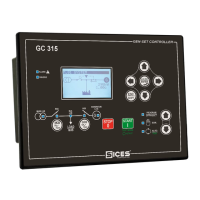162 GC315xx and GC400xx Technical Manual
This chapter describes all the anomalies managed by the controller. Some act as protection
for the loads, for the generator or for the engine. There is also signalling of specific events in
the plant management. Before describing them in detail, some definitions are required.
Three types of anomalies are:
Warnings: these anomalies do not require shutting the engine down. They point out
to situations that are not dangerous at the moment, but the operator must take some
action because, if ignored, they could degenerate in one of the following categories.
Downloading: these anomalies have characteristics similar to the deactivations (see
after). Not causing problems for the loads and for the generator though: in the parallel
operation case, it is preferable that the opening of the power connection is performed
only after that the power has been downloaded. This happens by means of the quick
ramp of download. It is impossible by the way to restart the engine until when the
anomaly has been acknowledged.
Deactivations: these anomalies require shutting the engine down. They create
hazards for the loads but not immediately for the engine. For this reason, the controller
opens immediately the GCB breaker (without discharging the power from the
generator), then it stops the engine with standard procedure, i.e. with the cooling
cycle. However, it is not possible to restart the engine until the anomaly has not been
acknowledged.
Failures: these anomalies require shutting the engine down. They create hazards for
the loads and/or for the engine and the generator. For this reason, the controller opens
immediately the GCB breaker (without discharging the power from the generator), and
stops the engine immediately with standard procedure, i.e. without the cooling cycle.
It is not possible to restart the engine until the anomaly is acknowledged.
To activate a failure, it is necessary that no other failures are already active (there are some
exceptions, they will be highlighted later). It can be there downloadings, deactivations and pre-
alarms instead.
To activate a deactivation, either failures nor other deactivations must be present. Other pre-
alarms and other downloadings can be present though.
To activate a downloading, either failures nor other deactivations or other downloadings must
be present. Other pre-alarms can be present though.
To activate a pre-alarm, either failures nor deactivations or downloadings must be present..
Other pre-alarms can be present though.
When an anomaly activates, the controller performs the following:
It activates the internal horn and, if configured, also the external one. To that purpose,
in fact, you can configure an output of the controller with the feature DOF.3152 –
“Outside siren”. The output is controlled together with the inside beeper; the purpose
is that of using a more powerful beeper or a lamp.
Prompts the page S.02 ANOMALIES on the multifunction display. This page shows
the numeric code and the current language text related to all active anomalies.
It activates the flashing of the “ALARM” indicator light, if the anomaly belongs to the
pre-alarm category, or it turns it on if the anomaly belongs to the category of
discharges, deactivations or interlocks.
If the anomaly is not a warning, the controller disconnects the generator from the load
or from the parallel bars (with or without download of power) and stops the engine
(with or without the cooling cycle).

